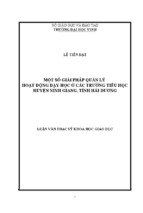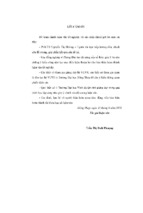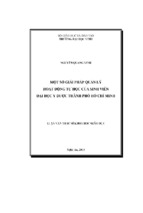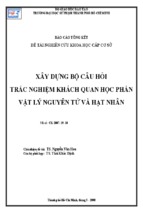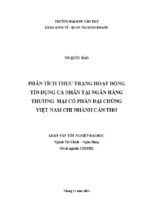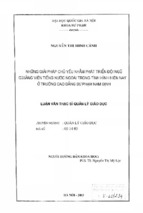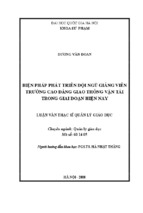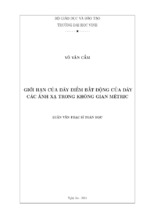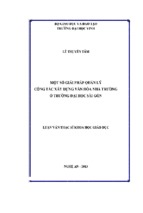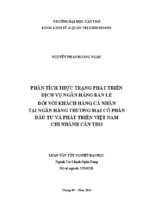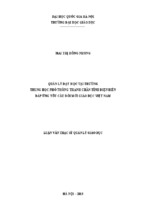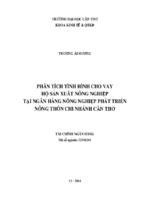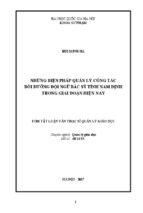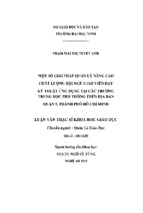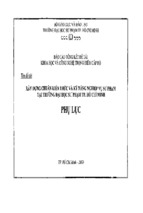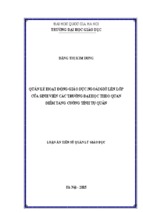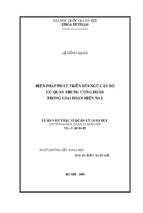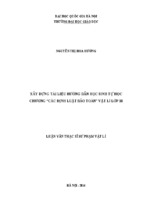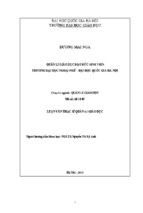i UNIVERSITY, HANOI
VIETNAM NATIONAL
UNIVERSITY LANGUAGES AND INTERNATIONAL STUDIES
FACULTY OF POST-GRADUATE STUDIES
--------------------------------------
A CONTRASTIVE ANALYSIS OF PROVERBS AND IDIOMS
RELATING TO ANIMALS IN ENGLISH AND VIETNAMESE
EQUIVALENTS
(Phân tích đối chiếu các câu tục ngữ, thành ngữ liên quan đến các động vật
trong tiếng Anh và cách biểu đạt tương đương trong tiếng Việt)
M.A. Minor Programme Thesis
Field: English Linguistics
Code: 60 22 15
HANOI - 2011
ii
Acknowledgements
My minor thesis has been successfully completed thanks to the assistance and guidance
of my teachers, classmates and relatives.
First of all, I would like to express my most sincere gratitude to my supervisor, Mrs.
Đào Thu Trang, MA for her enthusiastic assistance, academic guidance, good suggestions and
critical comments on my study.
Secondly, I would also like to show my gratitude to all the teachers of the Faculty of
Post-graduate Studies, University of Languages and International Studies, Vietnam National
University, Hanoi whose lectures and guidance have helped me much while carrying out this
study.
Thirdly, my deepest thanks are for my beloved colleagues and my friends who have
always stood by my side, have helped and encouraged me during my preparation till the
completion of the study.
Last but not least, I would like to acknowledge the considerate support and
indispensable assistance of my parents, my wife and my children while the work was being
done.
One more thing I would like to say is that in spite of all the efforts I have made and the
advice and assistance I have received, I am sure my minor thesis is far from perfect.
Therefore, it is my responsibility for any inadequacies and shortcomings that arise in my
minor thesis.
iii
DECLARATION
I hereby certify that all work in this thesis is my original work and the substance of this
thesis has not been submitted to any other university or institution. Also, I claim full
responsibility for the contents of the thesis.
The research reported in this thesis was approved by University of Languages and
International Studies, Vietnam National University, Hanoi.
Hanoi, September 30th, 2011
iv
ABSTRACT
One of the most typical elements of the implication of culture in language is the use of
proverbs and idioms. In communicative English, there is a huge number of idioms and
proverbs, and they are used very often in everyday conversation. The use of proverbs and
idioms causes many troubles for English learners because sometimes they are very confusing.
Therefore, English teachers have to teach the students not only the knowledge about the
language but also the knowledge about English culture so that the students can communicate
well.
Animals play a very important role in many cultures including English culture and
Vietnamese culture. A large portion of proverbs and idioms in English as well as in
Vietnamese contain the images of animals. There are some outstanding similarities and
differences between them. Within understanding this, English teachers and English learners
can deal with proverbs and idioms much more easily. However, there are so few works
focusing on this issue. For this reason, this paper aims at categorizing the similarities and
differences of proverbs and idioms relating to animals in English and Vietnamese as well as
giving out some explanation. On this basis, it also offers some educational implications for
English teachers and learners to make their teaching and learning more effective.
v
TABLE OF CONTENTS
DECLARATION
i
ACKNOWLEDGEMENTS
ii
ABSTRACT
iii
TABLE OF CONTENTS
iv
PART A: INTRODUCTION
1. Rationale
1
2. Aims of the study
3
3. Scope of the study
3
4. Methodology
3
5. Design of the study
4
PART B: DEVELOPMENT
CHAPTER 1 : THEORETICAL BACKGROUND
1.1 Relationship between language and culture
5
1.2 Literal meanings and idiomatic meanings
7
1.2.1 Literal meaning
7
1.2.2 Idiomatic meaning
7
1.2.2.1 Definitions of idiom
7
1.2.2.2 Some features of idiom
10
1.2.2.3 Types of Idiom
12
1.3 Proverb in relation to idiom
13
1.3.1
Definitions of proverb
13
1.3.2
Proverb versus Idiom
13
CHAPTER 2
SOME FEATURES OF ENGLISH –VIETNAMESE PROVERB AND IDIOM
2.1 Proverb and Idiom relation to Language and Culture
15
2.2 Comparison between English and Vietnamese proverbs and
16
idioms viewed from cultural identities .
vi
2.2.1 Based on principles of cultural types
16
2.2.2 Based on cognitive culture
22
2.3 Animal images in proverbs and idioms
2.3.1. Animal images in Vietnamese proverbs and idioms
25
2.3.2 Animal images in English proverbs and idioms
27
CHAPTER 3
A CONTRASTIVE ANALYSIS OF ENGLISH PROVERB AND
IDIOM RELATED TO ANIMALS VERSUS THE ONES IN VIETNAMESE
3.1 The cognitive similarities
31
3.1.1. Same expressions same meaning
32
3.1.2. Different expressions close meaning
32
3.2 The cross-cultural differences
33
3.2.1
View from Customs
33
3.2.2
View from Religions
36
3.3. Similarities and differences of English and Vietnamese
38
idioms about human characteristics through the images of animals
PART C: CONCLUSION
42
REFERENCES
44
1
PART A
INTRODUCTION
1. Rationale
Nowadays, English has been widely used in Vietnam. It is also a compulsory subject in
high schools.
In Vietnam, English has long been regarded as a tool of international communication,
and together with its rising importance, the need of learning English is becoming more and
more urgent. It can’t be denied that all foreign learners in general and Vietnamese learners in
particular desire to master English as the native speakers. However, they usually face a lot of
difficulties that prevent them from gaining successful conversations. One of the reasons for
these problems lies in the way people perceive and use idioms and proverbs.
English and Vietnamese are two different languages, that is, each of them embodies in
itself the cultural factors which characterize one culture from the others.
Therefore, it is unquestionable that to learn a foreign language also means to gain
benefits from its great stock of proverbs and idioms in which most cultural values are
reflected. However, most Vietnamese learners are taught English mainly with the knowledge
of language, not culturally appropriate factors embedded in the teaching language. They speak
English without the understanding of English communication manner. They write English
with
little
knowledge
misunderstanding
or
of
even
English
cultural
communicative
background.
breakdown.
Consequently,
Clearly,
without
it
causes
cultural
appropriateness, learning English in general and learning English proverbs and idioms in
particular seem to be a challenging process. It is really a risky road for learners to understand
and translate English proverbs and idioms into Vietnamese.
Each nation’s language has its own similar and different concepts on many fields of
life such as humane values, ways of thinking, behavior standards, religious beliefs, customs
and traditions, social convention, etc. Words and expressions including idioms and proverbs
have formed the vocabulary system of a language. Idioms and proverbs are regarded as
special factors of a language’s vocabulary system because they reflect cultural specific
2
characteristics of each nation, including material and spiritual values. Therefore, many
researchers have long shown their concerns for idioms and proverbs.
Idioms and proverbs are used to express ideas in figurative styles. They bring the
vividness and richness to the speakers’ speeches. This is the reason why the more skillfully a
person use idioms and proverbs in his conversations, the more effectively he can establish his
communicative relationship. One more important thing is that the general present tendencies
are towards proverbial and idiomatic usage; therefore, knowing how to use idioms and
proverbs effectively in the right situations is becoming essential. Moreover, the most
distinguished advantage of idioms and proverbs is that they do provide users with a whole new
way of expressing concepts linguistically. It can be said that idioms and proverbs are the color
and vitality of a language.
We all know that language is the most important means of communication in the
world. However, only when both the speakers and the listeners have a common understanding
about each other , can they communicate effectively. Actually, the culture and the language
are considered the two sides of a paper; both are inseparable from each other and from the
social context. In communication as well as in language teaching, the culture elements are
getting more and more important. Knowing the target language’s culture helps second
language learners comprehend the knowledge of that language more effectively.
It can be seen that proverbs and idioms are the windows on a nation’s identities. If the
window tightly closed, we would fail to decode the real message of a language in particular
and of a culture in general. This idea offers me a strong impetus to study proverbs and idioms
of English and Vietnamese equivalents in the view of cultural identities of each nation.
Being interested in idioms and proverbs for long time, I choose idioms and proverbs as
my thesis topic. Due to the limited time and knowledge, I just focus on a very small part of the
huge idiomatic and proverbial treasure, ‘ A contrastive analysis of proverbs and idioms
relating to animals in English and Vietnamese equivalents’. With the aim of presenting an
overview of proverbs and idioms in general and a contrastive analysis of proverbs and idioms
relating to animals in English and Vietnamese in particular, I hope it will partly help learners
3
and translators avoid difficulties in realizing and translating English proverbs and idioms into
Vietnamese and vice versa.
2. Aims of the study
The aims of the study are:
-
To discover cultural values through proverbs and idioms
-
To investigate the similarities and differences between English and Vietnamese idioms
denoting human characteristics through images animals.
-
To help the Vietnamese learner of English be more aware of English and Vietnamese
proverbs and idioms and how to use them in appropriate and interesting way.
-
Provide some suggestions for the teaching/learning and translation of the English
proverbs and idioms relating to animals.
3. Scope of the study
- Proverbs and idioms are large parts in both English and Vietnamese; thus it is
impossible for the author to carry out a comprehensive study on them; thus, he just focuses on
some proverbs and idioms relating to animals.
- In this study, the cross-cultural differences view from customs, religion are
extensively discussed; English idioms denoting human characteristics through the images of
animals are compared with Vietnamese ones.
- All English and Vietnamese proverbs and idioms are collected from dictionaries;
hence, this research may not cover all proverbs and idioms relating to animals, just those of
common use
4. Methodology
To achieve these aims, the author has discussed with supervisor, teachers, friends and
consulted many dictionaries and books of languages, idioms, proverbs, metaphor , magazines,
newspapers, etc. in both English and Vietnamese in which whatever relating to idiomatic and
proverbial expression containing ‘animals’ is taken into consideration. Then a comparative
4
analysis is designed to point out the similarities and differences between English proverbs and
idioms relating to animals and Vietnamese ones.
5. Design of the study
The study consists of three parts. The first part “Introduction” outlines the
background of the study. In this part, a brief account of relevant information is
provided such as rationale, aims, scopes, methods, and design of the study.
The main part of the study comprises three chapters. Chapter one, as implied by
the title ‘ theoretical background’ for the study. It consists of relationship between
language and culture, the literal meanings and idiomatic meanings,
proverbs in relation to idioms. Chapter two is
concerned with “Comparison of
cultural features between English-Vietnamese proverbs and idioms” , whereas
chapter three deals with “A contrastive analysis of Vietnamese proverbs and idioms
relating to animals versus the ones in English”
The final part is “Conclusion” , which provides the recapitulation, implications
for the EFL teaching and learning and for the translation, and suggestions for the
further studies. The study ends with the “References”
5
PART B: DEVELOPMENT
CHAPTER 1
THEORETICAL BACKGROUND
1.4 Relationship between language and culture
It is said that language is the highest and the most amazing achievement of human mind.
Most linguists currently regard the faculty of language as “ a defining characteristic of being
human” because it is what best distinguishes man from ogres and other animals.
Language is a creative product of human kind that helps to distinguish them from other
creatures on the earth and that serves the main purpose of communication. Language is not
occurring in isolation because human beings are not separate islands in the world of social
activities.
It is shown that the word ‘culture’ is used frequently in our daily life but ‘culture’ is not
easily defined, nor is there a consensus among scholars, philosophers and politicians (nor,
probably, among a rest of us) as to what exactly the concept should include. Despite a century
of efforts to define culture adequately, there was in the early 1990’s no agreement among
anthropologists regarding its nature.
Another common way of understanding culture
is seeing it as consisting of three
elements: values, norms, artifacts. Values comprise ideas about what in life seems important.
They guide the rest of the culture. Norms consist of expectations of how people will behave in
different situations. Each culture has different methods, called sanctions, of enforcing its
norms. Sanctions vary with the importance of the norm; norms that a society enforces formally
have the status of laws. Artifacts-things or material culture-derive from the culture’s values
and norms.
Culture, in this study, like in Nguyen Quang (1998:3), is not “high culture” (traditionally
the milieu of arts, music or sciences and so on) but “refers to the informal and often hidden
patterns of human interactions, expressions, and viewpoints that people in one culture share”.
6
“No culture is good or bad, just different!”. And there is a famous quote of Mahatma
Gandhi “No culture can live, if it attempts to be exclusive”. Nguyen Quang (1998:3) also
emphasizes “it is best not to overemphasize either culture differences or cultural similarities.
Those who says, “We are all alike; we’re all human” deny the shape and flavor that cultures
contributes to individual development. Those who say, “We’re so different that we must stay
separate” create harmful barriers by closing their eyes to what is common to every human
being” .
Culture does not belong to any single person but to all people. Nguyen Quang in
“Intercultural Communication” (1998:3) describes “culture’ as “ a share background (for
example, national, ethnic, religious) resulting from a common language and communication
style, customs, beliefs, attitudes, and values”.
What we can derive from these points of view is that the language of a community is a part
or a manifestation of its culture as Goodenogh’s word “ the relationship of language to culture
is that of part to whole”. Language and communication modality (verbal, gesture, written) are
examples of elements that form and shape a culture. Kramch-Troike (1998:3) clarifies the
correlation between language and culture by emphasizing three functions of language related
to culture. They are “expressing cultural reality, embodying cultural reality and symbolizing
cultural reality”.
In its turns, culture influences the way in which language is used. Culture is the final
arbiter of meaning or linguistic meaning is entirely determined by the cultural context in
which the language occurs.
In conclusion, there is a close relationship between language and culture; knowledge of
the target culture remains an important part of language learning, especially at higher levels.
That is the reason why culture learning should always go hand in hand with language learning
though it may take a longer time and make language teaching and learning more challenging
than ever.
7
1.5 Literal meanings and idiomatic meanings
According to Dr. Duong Ky Duc (2003), the meanings of a word are not only the literal
meaning, but also the figurative meaning. These meanings of the word do not exist separately
but together as a perfect whole. In this sense, the literal meaning is the center and the
figurative meaning is the extension, which shows the cultural distinction of using the word
between this commodity and others. However, we focus much on idioms relating to animals,
therefore, besides the literal meanings of the words containing ‘animals’, we mainly study the
figurative meanings of these idioms which are, in the study, called the idiomatic meanings.
1.5.1
Literal meaning
The literal meaning of a word is the strict dictionary meaning of a word, the ‘dictionary
definition’. For example, if you look up the word ‘snake’ in a dictionary, you will discover
that one of its literal meanings is ‘any of numerous scaly, legless, sometimes venous reptiles
having a long, tapering cylindrical body and found in most tropical and temperate regions’.
Obviously, idiom has its idiomatic meaning. Many idioms, however, can also have
both the literal and idiomatic meanings. In the study, the author does not focus on the literal
meanings of all the idiomatic expressions containing the words relating to ‘animals’ but ones
of the words relating to ‘animals’, which are, somehow, related to the idiomatic meanings of
the idiomatic expressions containing the words relating to ‘animals’.
1.2.2 Idiomatic meaning
1.2.2.1 Definitions of idiom
English idiom
In Cambridge International Dictionary of idioms, idiom is defined as a colorful and
interesting aspect of English. They are used generally in all types of language, informal and
formal, spoken and written.
Idiom regularly has a stronger meaning than non-idiomatic phrases. For instance, “look
daggers at someone” has more highlighting meaning than look angrily at someone, although
they signify the similar thing.
8
Idiom may also imply a particular attitude of the person using them, for example,
disapproval, humor, irritation or admiration.
Words do not just come individually; they also come in expressions – in-group. Idioms
are among the most common of these expressions (Wright, 2002).
Idioms itself have grammar. Some idiomatic expressions are fixed and cannot be changed
such as :
Two head are better than one.
(Ba anh thợ gia bằng Gia Cát Lượng)
However, in most cases, we can change the tense and the pronoun such as I am/She is/We
are all at sixes and sevens.
According to Wright, idiom is an expression with following features. Firstly, idiom
is fixed and is recognized by native speakers. We cannot make up our own idioms. The
second feature is that idiom uses language in a non-literal-metaphor-way. Take these
idioms as examples.
Tin is up to his eyes in work now
At the meeting, I felt a bit out of my depth.
I was over the moon when I heard she’d had twins.
It broke my mother’s heart to see her home burnt to the ground.
If you are up to your eyes, you are very busy. When a person is out of her or his
depth, he/she might be in the sea but he/she is more likely to be in a circumstance that
he/she cannot comprehend for some reasons. If you are over the moon, you are extremely
joyful about something. If something breaks your heart, you are very gloomy about it.
In these examples, it is clear that the idiom is a whole expression. This is the
traditional view of idioms.
We are familiar with the idea of heavy rain causing a stream to overflow and flood
the surrounding area; crowds are often described as water and the same verb flood is used.
The literal meaning of a hot potato, it is not for eating; it means a controversial issue. Idioms
are very important because they are commonly used in daily life. It is nearly impossible to
speak, read or listen to English without meeting idioms. The next reason is the metaphorical
9
use of a word is more common today than its literal meaning. However, it is important to
know its literal meaning because it creates a picture in our mind and this picture enables us
to understand other meanings more easily. The last reason why idioms are so important is
that they are fun to learn and to use. If the language you want to learn is more colorful and
interesting, there is more chance that we will remember it clearly. Our English will sound
more natural.
Vietnamese idioms
According to Hung, in Vietnamese, idioms frequently use fixed expressions;
grammatically, they are not complete sentences, which mean they are only words or phrases.
Idioms do not show any comments, experiences, ethnical lesson or critics, so they often have
figurative function, not educational function. For example, in Vietnamese we say “mặt hoa
da phấn”. This idiom only brings us a picture of a beautiful and charming woman but not
lesson about ethnics or critics.
Most of idioms are formed from incomplete meaning words; they cannot stand
alone but in a sentence. Vietnamese idioms are often used in proverbs, folk songs, or
literature works. That makes idioms meaningful only when they are in sentences. Take this
as an example, “công dã tràng”, at least, it has to be in sentence: “đúng là công dã tràng”
or “chuyện anh làm chỉ là công dã tràng”. Instead of expressing an idea literally, people
tend to use idiom to make their speech more beautifully or funnier. For example, to express
the idea of a person who sometimes works, sometime does not, we use this idiom “hắn ta
đi làm bữa đực bữa cái”.
Idioms use brief expressions based on stories, folk tales, or classic references,
which happened a long time ago. Now we encounter similar situation, thus by hearing
those idioms, the listener knows exactly what the speaker means. Many Vietnamese
idioms are borrowed from Chinese idioms; however, Vietnamese cleverly transformed
those Chinese idioms into Vietnamese way of talking. For example, “huynh đệ thủ túc”,
in Vietnamese, we have this equivalence “anh em như thể tay chân”.
10
1.2.2.2 Some features of idiom
It is asserted that language follows rules. If it did not, its users would not be able to
make sense of the random utterances they read or heard and they would not be able to
communicate meaningfully themselves. Idiom, however, breaks the normal rules. The word
‘idiom’ comes from the Greek ‘idiot’, ‘one’s own, peculiar, strange’. Hence, idiom is
considered anomalies of language, mavericks of the linguistic world; and most of the linguists
when studying features of idiom have focused on these animalities of idiom. Idiom may be
characterized by several features; but they may be summarized under two main headings:
semantic and syntactic peculiarities.
In terms of semantic peculiarities, Jackson and Amvela (2000:67) indicate that idiom
has “ambiguity”, it means that idiom may have either a literal or an idiomatic meaning. For
example,
If someone “beats a dead horse”, they may in fact be in the process of striking the
carcass of an animal (literal meaning); or they may be wasting time discussing a matter that
has already been closed (idiomatic meaning). Similarly, “To sit on the fence” can literally
mean that one is sitting on a fence “I sat on the fence and watched the game”; whereas its
idiomatic meaning that one is not making clear choice regarding some issue “The politician
sat on the fence and would not give his opinion about the tax issue”. However, once a reader
or hearer realizes that a given expression is idiom, even if they are not sure of its exact
meaning, they will automatically discard the literal meaning of the expression, and seek an
idiomatic meaning. Furthermore, the context in which the idiom occurs also play an important
role in the reduction of this potential ambiguity.
Another noticeable
semantic feature of idiom is affirmed by Cruse (1986: 37-38):
“although idiom consists of more than one word, it displays to some extent the sort of internal
cohesion that we expect of single words”. In order words, idiom may be characterized as “a
lexical complex, which is semantically simplex”. And this semantic integrity of idiom leads to
its lexical integrity. It means that idiom has a number of syntactic (grammatical) constraints:
The first constraints are on replacements or substitutions. Fernando (1996:43-45)
shows that an idiom may be varied in terms of number and tense (inflectional changes)
11
or the replacement of one structure word like an article by another or by zero. He gives
some examples:
+ “ He smelt a rat and he kept mum” (past tense, past time)
( The Oxford Dictionary of Current Idiomatic English 1983)
“Everybody smells a rat in a doctored obituary, even the window”
(Present tense indicating a timeless truth)
( The Oxford Dictionary of Current Idiomatic English 1983)
However, these replacements can be only applied to a small number of idioms. In
general, most idioms are indivisible units whose components can’t be varied. Some do not
permit pluralization like in “kick the buckets” (kick the bucket) or “smell the rats” (smell a
rat); some do not permit singularization such as “twiddle one’s thumb” (twiddle one’s
thumbs) or “ raining a cat and a dog” (raining cats and dogs). In addition, replacement of
characteristic lexis in idiom isn’t possible even synonymous words. For example, in “we look
forward to meeting you”, “look” can not be replaced by “see” or “watch”. Hence, “we
see/watch forward to meeting you” is not idiomatic. Similarly, in “wash one’s dirty linen in
public”, ‘linen’ can not be replaced by ‘socks’, neither can ‘thought’ be replaced by ‘idea’ in
‘have second thoughts’ .
Idiom also resists re-ordering of its parts. We consider “ John kicked the bucket”. In
the literal sense, this expression has a passive variant, “ The bucket was kicked by
John” . But in its idiomatic use, i.e. when “kicked the bucket” means “died”, the
expression does not allow the use of the corresponding passive alternative. Other
changes of the order of the words like in “The short and the long of it” (The long and
the short) or in “What Peter pulled was his sister’s leg” (What Peter did was pull his
sister’s leg) are impossible.
Additions and deletions are also not normally permitted within idiom. Thus, we can’t
say “To pull someone’s left leg” and “To kick the large bucket” , they have no normal
idiomatic interpretation because of the addition of ‘left’ and ‘large’ , whereas ‘straight
from horse’s mouth’ and ‘turn a new leaf’ are both unacceptable because ‘the’ and
‘over’ have been omitted.
12
Such constraints make idiom fixed or invariant and separate them from non-idiom. Cruse
(1986:38) recognizes another feature of idiom which shows its status as phrases in a way that
“if idiom may be inflected, the inflectional affixes are carried by the grammatically
appropriate elements within the idiom, whether or not they are semantic constituents; that is to
say, the elements of idiom retain at least some of their grammatical identity:
“ John has a bee in his bonnet about many things” (John luôn bận tâm về mọi thứ)
(*John has bees-in-his bonnets about many things)”; this expression is wrong because the
grammatical appropriate elements “ have a bee in one’s about something” is invariant, it
does not permit pluralization.
1.2.2.3 Types of Idiom
Fernando (1996:35-36) states that idiom can be divided into three sub-classes: pure idiom,
semi-idiom, and literal idiom.
A pure idiom is “a type of conventionalized, non-literal multiword expression”; that is
to say the meaning of a pure idiom has nothing to do with the meaning of its constituents.
Hence, “spill the beans” has nothing to do with ‘beans’ . In contrast to its literal counterpart
meaning, “letting fall leguminous seeds”, a non-literal meaning is imposed on the idiom as a
whole: “commit an indiscretion”.
A semi-idiom “has one or more literal constituents and at least one with a non-literal sub
sense, usually special to that co-occurrence relation and no other”. Examples of semi-idiom
are “catch one’s breath” (check one’s breath) or “foot the bill” (pay the bill) in which
“catch” and “foot” are non-literal constituents .
Literal idiom (on foot, waste not, want not, on the contrary, a happy birthday, a merry
Christmas and a happy New Year, etc.) “meet the salient criterion for idiom: invariance or
restricted variation. They are, however, less semantically complex than pure and semi-idiom”.
13
1.6 Proverb in relation to idiom
1.6.1
Definitions of proverb
There have been many definitions of a proverb but there is no standard one that can be
used to study all aspects of proverb. Let’s consider some definitions of proverb that
Vietnamese and foreign researchers have made.
-
Proverbs can be defined as “a short saying or sentence that is generally known by
many people. The saying usually contains words of wisdom, truth or morals that are
based on common sense or practical experience.”(www.Theidiomconnection.com)
-
A short saying that everyone knows, expressing a truth, an experience or giving
advice. (English version by Bach Anh Hong/Viện ngôn ngữ học, 1992)
Although the above definitions are different in some ways, they still have similarities:
a saying expressing a truth, moral instruction or giving advice.
1.6.2
Proverb versus Idiom
According to Hornby (1995), in his Oxford Advanced Learner’s Dictionary, proverb is
defined as “a short well-known sentence or phrase that states a general truth about life or
giving advice, ex. Better safe than sorry or Don’t put all your eggs in one basket”. More
particularly, Vu Ngoc Phan (2000:39) considered proverb as “a complete saying expressing
one idea of comment, experience, morality, justice or criticism”.
It is easy to find that idiom and proverb have much in common and it comes as no
surprise that they are traditionally studied together. The first one is that both idiom and
proverb are ready –made. They are products of human’s thought, cultures and processes of
hard working and learning. They are mainly orally handed down from generation to generation
and naturally accepted in daily life. Secondly, both idiom and proverb are set-expressions with
stable and components are not substituted . Therefore, their meanings can not be deduced from
individual words but must be understood as a whole. It means that any substitutions in any
components of idiom or proverb may result in unacceptable changes in the meaning of whole
group, which make them nonsensical in metaphorical meaning. Apart from this, most idiom
and proverb use language in metaphorical way. We cannot usually discover their meanings by
14
looking up the individual words in a dictionary; their
meanings must be understood
metaphorically.
Beside those similarities, both of them still own typical features that distinguish one
from the other. The first and most obvious difference lies in their grammatical structures.
Idiom is a phrase which is a part of sentence; thus, it is equivalent to words only.
Proverb is a complete sentence or a phrase expressing the whole idea. Moreover, idiom
and proverb are also different in terms of their functions. Proverb is a short well-known
sentence or phrase that expresses a judgment, state a general truth about life or advice; it is
told to contain three main literature functions which are perceptive function, aesthetic
function, and educational function. For example, the proverb ‘Money makes the mare go’
demonstrates a remark as well as a criticism about the negative side of money. Its perceptive
function is to make people aware of the bad effect of money which can become the power
dominating the society, even the most inanimate things. The educational function is to criticize
the negative side of money and urge to be aware of that ill effect. And its aesthetic function is
to exaggerate in a picturesque way to help readers understand the proverb easily. In contrast,
idiom does not express judgments, give advice or state general truth about life, which means it
does not have functions of perception and education but only aesthetic function. For example,
the idiom “to eat like a horse “ merely describes the ability of eating strongly of someone
because of great hunger in figurative and imaginary way and does not point out
any
educational lesson or knowledge of life.
In short, beside their common things, idiom is distinguished from proverb by its
structures and functions.
- Xem thêm -


